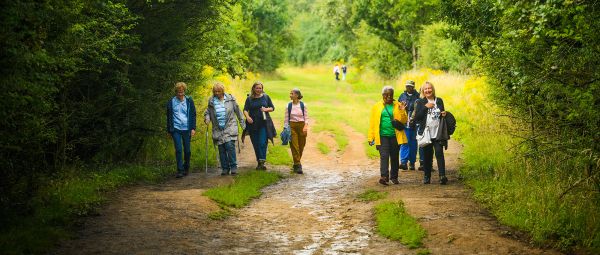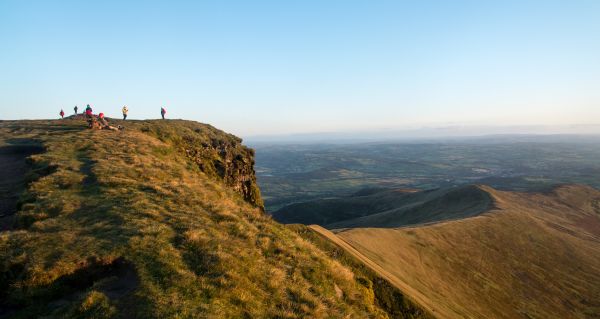5 key moments in the people-powered fight for the Freedom to Roam

The Freedom to Roam covers some of England's most famous landscapes, from the tors of Dartmoor to the fells of the Lake District. If you’ve ever visited these sorts of areas, you’ve probably enjoyed the Freedom to Roam, even if you didn’t realise it. And nothing compares to the feeling of walking freely. To go off-path and wander without worry, reconnecting with the natural world that surrounds us.
But this freedom has not always been available to us. In fact, we had to fight for this right.
And that fight is not over yet. As part of our campaign to unlock the outdoors, we’re calling for the Freedom to Roam to be expanded to woodlands, watersides and more downland. It’s the next major milestone in this story. And by taking our pledge to unlock the outdoors, you have the chance to become part of it.
So we’ve gathered together five key moments in our fight for greater access. Moments that explain how we got the rights we have now and, crucially, why it’s time for progress.
Let’s start 100 years ago...
1. 1932: The Kinder Trespass ignited a movement
In England’s industrialised towns and cities, appreciation for the benefits of exploring the outdoors was growing. But without the right to access the countryside on their doorsteps, those wanting to experience the freedom of the outdoors found themselves in conflict with landowners.
Then, in 1932, an historic act of protest brought the freedom to roam squarely into the public eye: the Kinder Trespass.
On 24 April 1932, around 400 ramblers set out from the village of Hayfield towards Kinder Scout, a moorland plateau high in the Peak District. Gamekeepers, employed by landowners, tried to turn them back. But, outnumbering their opponents, the ramblers broke through and reached the summit.
With their trespass successful, the ramblers returned back to Hayfield to find the police waiting for them. Five members of the protest were arrested, including their leader Benny Rothman. All pleaded not guilty but two months later they were all jailed for between two and six months.
The harshness of the punishment became headline news, unleashing a wave of public sympathy and attention to the cause. The trespass also spawned a surge of similar protests across the country: in June of the same year, over 10,000 people attended an access rally at nearby Winnats Pass.
The Kinder Trespass ignited the debate about common access to the countryside and has gone down as one of England’s most historic protests. Nearly 70 years later, Lord Roy Hattersley, former deputy leader of the Labour party, would describe it as “the most successful direct action in British history.”
2. 1935: The Ramblers was founded to fight for the interests of walkers
From the mid-nineteenth century onwards, walking clubs and groups began popping up across the country. But it was the seismic impact of the Kinder Trespass that galvanised them into action.
In 1931, a number of disparate groups had come together to form the National Council of Ramblers Federations. But after Kinder, they needed to create something bigger: something capable of fighting for the interests of walkers.
So the Ramblers, then known as the Ramblers Association, was born.
3. 1985: The Ramblers’ Forbidden Britain campaign channelled the spirit of Kinder
For the next 50 years, the Ramblers were at the forefront of the fight for greater access.
And in 1949, we saw our greatest triumph yet: the National Parks and Access to the Countryside Act.
From helping to create our treasured National Parks to protecting the 140,000 miles of rights of way that weave through our countryside, we achieved a step change in how we all access the countryside.
But just getting access wasn’t enough; it needed to be responsible access. After direct campaigning by the Ramblers, the act also introduced the Countryside Code.
Having overseen the founding of 10 national parks and the establishment of our first national trails, the Ramblers turned their attention back to the Freedom to Roam. And, in 1985, we launched Forbidden Britain, a new campaign to revive the spirit of Kinder and once again bang the drum for the Freedom to Roam.
The campaign was launched with a rally at Snailsden Moor. And every year, the campaign grew with rallies spreading all over the country.
4. 2000: Success! The Countryside and Rights of Way Act secured our Freedom to Roam
As the rallies spread and we lobbied, pressure began to grow. And in 1995, this lobbying bore fruit: the Labour party, then in opposition, announced that access to the countryside would be part of their political platform.
Then in 2000, almost 150 years after James Bryce MP first introduced a bill calling for the Freedom to Roam, the Countryside and Rights of Way Act 2000 was given royal assent and became law.
Three million acres was opened up for public access and for the very first time, we were given the legal right to walk freely over mountain, moor, heath and down. From the Kinder Scout plateau that sparked a movement to the moors of the West Country, everyone could now enjoy walking freely in some of the most picturesque parts of England and Wales. The Freedom to Roam had finally been established.
But the work didn’t stop there. Supported by the dedicated work of Ramblers volunteers, millions of acres of open countryside were identified and mapped. And four years later, we reconvened and plotted to how to expand access even further.
The CROW Act had successfully expanded our access to mountain, moor, heath and down. But this left out one landscape that had been included in the National Parks and Access to the Countryside Act: cliffs and the foreshore.
Another campaign began. Five years later, in 2009, the England Coast Path was announced in the Marine and Coastal Access Act. This new National Trail would not just be the longest continuous walking trail in the world; it was also a corridor of access, expanding our freedom to roam to the coastal areas that had been neglected in 2000.
5. 2024: Bringing the Freedom to Roam to everyone
Where we have the freedom to roam, its benefits are clear. Now, we need to bring those benefits far closer to the millions of us who are disconnected from nature.
The original Countryside and Rights of Way Act gave us access to some of the most dramatic landscapes in England. But for many, these areas are just too remote and it is our most deprived communities that are furthest away.
We want to bring the freedom to roam to everyone’s doorsteps. By expanding it to cover woodland, watersides and more grassland, we could bring the freedom to roam within a 20-minute walk for our most deprived groups. And give us all a chance to experience the joy of roaming free.
In 2000, we took our first step towards opening the way for everyone to explore and enjoy the outdoors. Now, with a general election looming, we can bring those benefits to millions more. Join us today by calling on all parties to introduce a new Access to Nature Bill.

Expand the freedom to roam
Help us to expand the freedom to roam. It is one of the biggest things we can do to increase access to the outdoors for everyone.

Freedom to roam - What we think
The freedom to roam should be extended so that it is more equally accessible and better connected to our footpath network, as well as our towns and cities.

Where you can walk in England and Wales
Helping you understand your rights, where you’re allowed to walk, and how to find new places to explore.